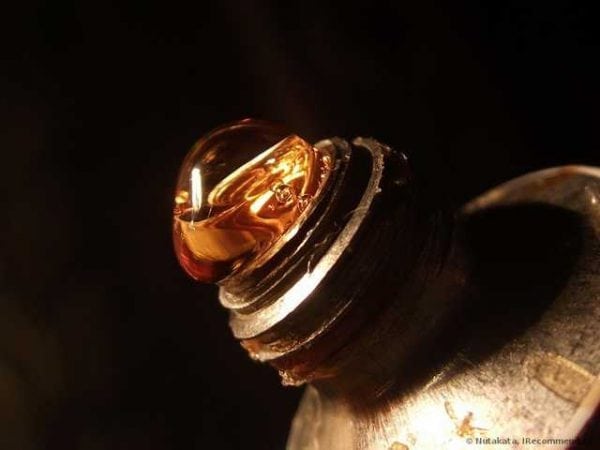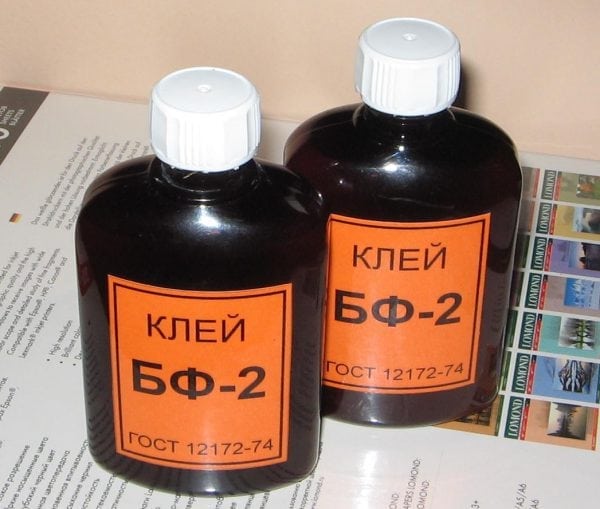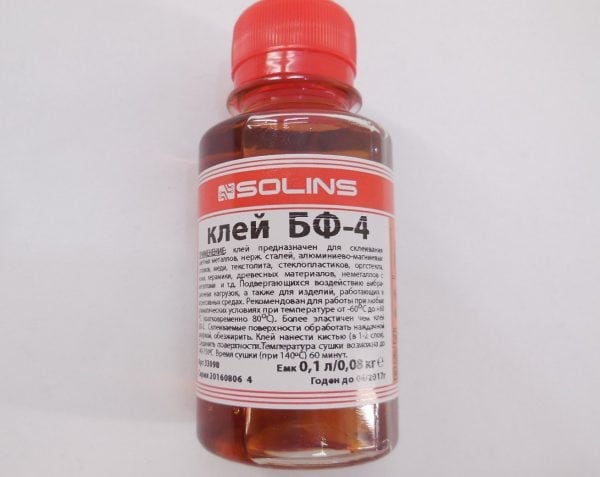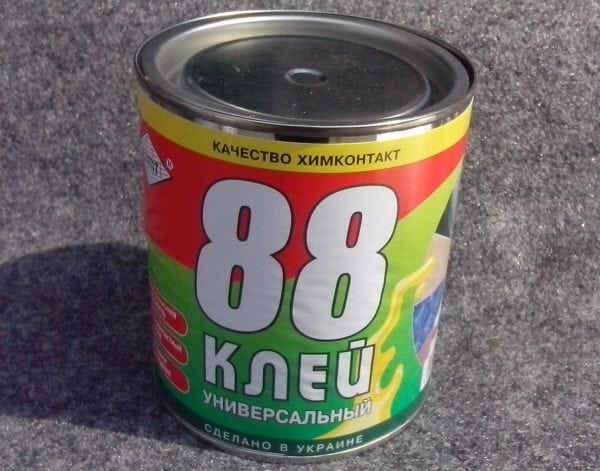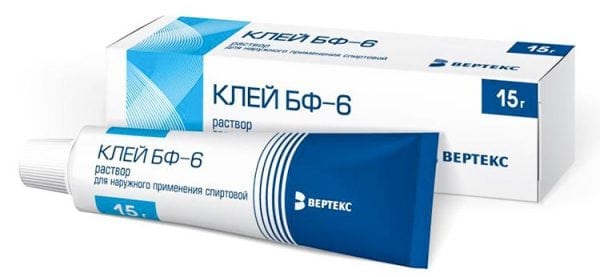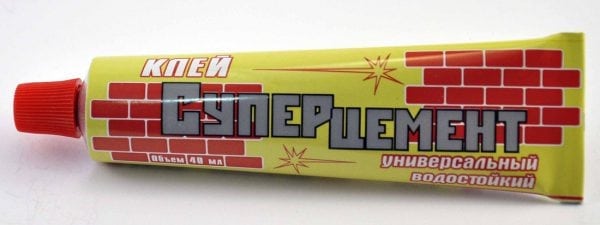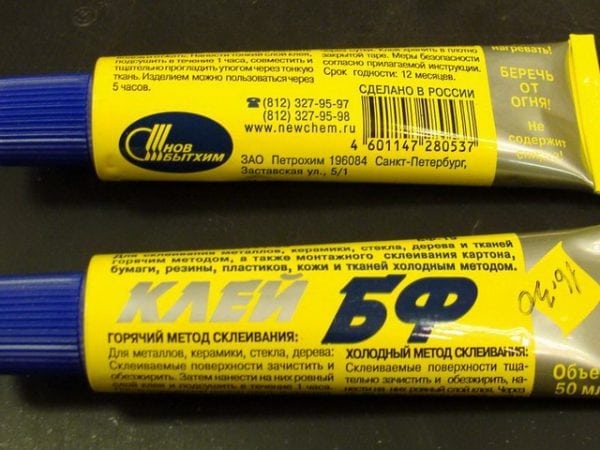BF glue and its varieties in everyday life and in repair work have been used for more than a dozen years. This tool is perfect for bonding various materials, from fabric and plastic to ferrous metals. There is even medical glue in the series, it is used to "seal" wounds and abrasions.
- Glue composition
- Origin history
- Scopes and characteristics
- Bf-2
- Bf-4
- BF-2N and BF-4N
- Bf-88
- Bf-19
- Bf-6
- Instructions for use BF-2 and BF-4
- How to remove BF glue
- Analogs of glues brand BF
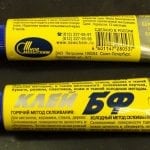
Glue composition
Depending on the specific brand, the chemical composition of the BF glue may be different. All funds of the series are produced according to GOST 12172-74.
By deciphering the name (butyralphenol adhesive), it will be clear to a specialist that the main component is polyvinyl butyral (or polyvinyl acetal). The number after the indication of the brand BF indicates the percentage of the main component in the dry matter, which gives the material elasticity.
Different types of BP can have an unequal amount of such components - the more they are, the higher the ductility of the dry adhesive layer, but the lower the strength. The glue contains:
- phenol formaldehyde or phenol polyvinyl acetate resin;
- ethyl alcohol (solvent).
The latter component can be replaced by the manufacturer with chloroform or acetone. BF-6 medical glue is dissolved only with alcohol.
In appearance, all products are thick solutions of yellowish, brown, brown, reddish color. Adhesives are flammable.
to contents ↑Origin history
The tool was invented in 1946, immediately after the war. It was invented by the scientist-chemist G. Petrov (he also discovered the plastic mass of carbolite), and the BF-2 glue was first created. Medical glue was produced in 1950, the discovery of its possible use was made by the surgeon L. Shkolnik.
Scopes and characteristics
The properties of the materials, their description, technical characteristics vary depending on the exact brand. Typically, adhesives are used in everyday life, but are not recommended for gluing dishes due to the presence of a number of toxic components (with the exception of BF-19).
to contents ↑Many BF adhesives are considered universal and can stick a variety of materials. BF-2 and BF-4 adhesives are analogues in chemical resistance and heat resistance, but there are differences in application. Other means are less popular and are used much less often.
Bf-2
According to the instructions for use, the adhesive is intended for bonding static rigid products that do not move during operation. BF-2 is well suited for bonding plastic, ceramic, metal, wood, glass, marble. Previously, it was used to repair microphones, speakers, and other acoustic equipment. The tool can be used for varnishing and impregnation of certain materials, carrying out restoration work.
After hot polymerization, the glue allows you to create a low-elastic seam, its heat resistance - up to +180 degrees. The composition provides the tool resistance in an acidic environment when heated to + 60 ... + 80 degrees.Here are the features and basic parameters of the material:
- viscosity on a VZ-1 viscometer at a temperature of +20 degrees - 30-60 s;
- fraction of solids - 14 - 17%;
- tensile strength of the joint at shear at a temperature of +20 degrees - 19.6 MPa (kgf / sq. cm);
- film bending after hardening - 3 mm.
to contents ↑Adhesive viscosity can increase when stored at temperatures below 0 degrees. Before use, it should be kept at room temperature for 3 days. BF-2 is resistant to the effects of oil, gasoline, kerosene, acids, water, mold, is limitedly resistant to the effects of alcohol, alkali, acetone.
Bf-4
The composition can glue the skin, glass, metal, wood and other materials in products that are subject to vibration, bending. It is excellently recommended for use on copper, aluminum-magnesium alloys, steel, fiberglass. The tool can stick metals with non-metals.
BF-4 glue is resistant to alkali and can be used at low temperatures. A distinctive property of the material is resistance to the action of salt fog and the presence of electrical insulation capabilities.
The main technical parameters of the product:
- viscosity on a VZ-1 viscometer at a temperature of +20 degrees - 30-60 s;
- fraction of solids - 10 - 13%;
- tensile strength of the joint at shear at a temperature of +20 degrees - 19.6 MPa (kgf / sq. cm);
- film bending after hardening - 1 mm.
When hardening at a temperature of + 160 ... + 175 degrees, BF-4 gives the most durable seams, which makes the hot method of application the most popular. Above the upper limit of the range, the product should not be used, this reduces its strength. Reducing the rate of repeated strokes on the glued surface.
to contents ↑BF-2N and BF-4N
Tools are used for bonding parts and products made of ferrous metals. Operating temperature after drying - from -60 to +80 degrees. The main technical parameters of BF-2N and BF-4N are not different:
- viscosity on a VZ-1 viscometer at a temperature of +20 degrees - 30-60 s;
- tensile strength of the joint at shear at a temperature of +20 degrees - 19.6 MPa (kgf / sq. cm);
- the proportion of solids - 14 - 17%.
Bf-88
BF-88 glue is used for gluing metals with non-metallic products. What else is glue for? The tool is needed to connect fabrics, wood, glass, ceramics, leather, plastic, various synthetic materials. Glue is recognized as universal, as it is suitable for many repair work in everyday life.
The composition of this tool is a mixture of chloroprene rubber, ethyl acetate, nephras, phenol-formaldehyde resin. It looks viscous, gray-green or beige; a precipitate may precipitate. The product is produced in tubes and in industrial containers - 25 - 50 liters.
to contents ↑Bf-19
BF-19 glue is intended for hot bonding of glass, ceramics, metals, wood. Using the cold method, you can glue fabric, cardboard, paper, plastic, rubber. The fabric can be glued using an iron.
Feature - strong toxicity. it is impossible to fasten dishes, other household accessories, use for medical purposes.
How to dissolve the product? For this purpose, as with other BF adhesives, acetone can be used.
to contents ↑Bf-6
Material BF-6 Bakelite based varnish is a medicine. It is widely used for antiseptic processing and the creation of films on wounds, abrasions.
Glue covers postoperative sutures, used in dentistry. It can be used by everyone except children under one year of age and in case of allergy to components.
to contents ↑Instructions for use BF-2 and BF-4
The use of BF-4 glue is as follows: first you need to prepare the surfaces well (they are sanded, cleaned with rags, degreased).
For the hot gluing method, the technology is as follows:
- apply an even layer of glue to the parts;
- leave for an hour;
- then squeeze the parts together, hold at a temperature of + 150 ... + 170 degrees 40 minutes;
- cool the product to room temperature gradually.
If tissue gluing is performed, the method is as follows. A thin layer of the product is applied to a little moistened with water and squeezed fabric, dried for an hour. Next, the products are connected, ironed with a hot iron. How long does the glue dry during a hot application? You can use the products after 5 hours - so much is needed for final drying.
The cold way is simpler. After applying the glue after 20 minutes, perform the second layer, after a couple of minutes, press the products to each other. You can use them after 24 hours.
BF-2 glue is applied after stripping and degreasing of parts. After applying the first layer after 10 minutes, perform the second with a brush. For the hot method, the products are placed in the oven for 60 minutes at + 130 ... + 140 degrees. For the cold method, the details are squeezed in a vice and left for 20 minutes, then put in a ventilated room for a day.
to contents ↑How to remove BF glue
If the material has got onto inappropriate places, contaminated clothing, skin, you can easily remove it. The glue is removed with alcohol or vodka, in which sponges are wetted. After 20 minutes, the base should be re-treated, removing the remaining glue.
to contents ↑You can remove the product from the fabric with a solvent using a cotton pad. You should first check on the back of the product for streaks or discolored stains on the fabric.
Analogs of glues brand BF
Replacing funds is difficult. The glue has a unique composition and properties, there are no exact analogues on sale. For all materials except metal, Supercement glue can be used.
Partially duplicates the properties of BF epoxy glue, but it is more difficult to work with it. BF adhesives are economical and have many other advantages, so it is better to use them, rather than analogues.

